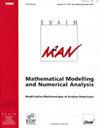Beris-Edwards系统一阶半离散格式的收敛性
IF 1.9
3区 数学
Q2 Mathematics
Esaim-Mathematical Modelling and Numerical Analysis-Modelisation Mathematique et Analyse Numerique
Pub Date : 2023-09-06
DOI:10.1051/m2an/2023071
引用次数: 0
摘要
本文给出了基于不变能量二次化方法(IEQ)的水动力q -张量模型Beris-Edwards系统的无条件能量稳定一阶半离散数值格式的收敛性分析。该模型由流体流动的Navier-Stokes方程和描述液晶分子排列的q -张量梯度流组成。采用不变能量二次化方法,得到线性隐式格式,加快了计算速度。然而,这引入了一个辅助变量来代替体势能,并且先验地不清楚重新表述的系统是否等同于Beris-Edward系统。在这项工作中,我们证明了该方案的稳定性,并证明了它收敛于耦合液晶系统的弱解。我们还证明了在弱意义上重新表述的系统与原始系统的等价性。本文章由计算机程序翻译,如有差异,请以英文原文为准。
On the convergence of an IEQ-based first-order semi-discrete scheme for the Beris-Edwards system
We present a convergence analysis of an unconditionally energy-stable first-order semi-discrete numerical scheme designed for a hydrodynamic Q-tensor model, the so-called Beris-Edwards system, based on the Invariant Energy Quadratization Method (IEQ). The model consists of the Navier-Stokes equations for the fluid flow, coupled to the Q-tensor gradient flow describing the liquid crystal molecule alignment. By using the Invariant Energy Quadratization Method, we obtain a linearly implicit scheme, accelerating the computational speed. However, this introduces an auxiliary variable to replace the bulk potential energy and it is a priori unclear whether the reformulated system is equivalent to the Beris-Edward system. In this work, we prove stability properties of the scheme and show its convergence to a weak solution of the coupled liquid crystal system. We also demonstrate the equivalence of the reformulated and original systems in the weak sense.
求助全文
通过发布文献求助,成功后即可免费获取论文全文。
去求助
来源期刊

CiteScore
2.70
自引率
5.30%
发文量
27
审稿时长
6-12 weeks
期刊介绍:
M2AN publishes original research papers of high scientific quality in two areas: Mathematical Modelling, and Numerical Analysis. Mathematical Modelling comprises the development and study of a mathematical formulation of a problem. Numerical Analysis comprises the formulation and study of a numerical approximation or solution approach to a mathematically formulated problem.
Papers should be of interest to researchers and practitioners that value both rigorous theoretical analysis and solid evidence of computational relevance.
 求助内容:
求助内容: 应助结果提醒方式:
应助结果提醒方式:


